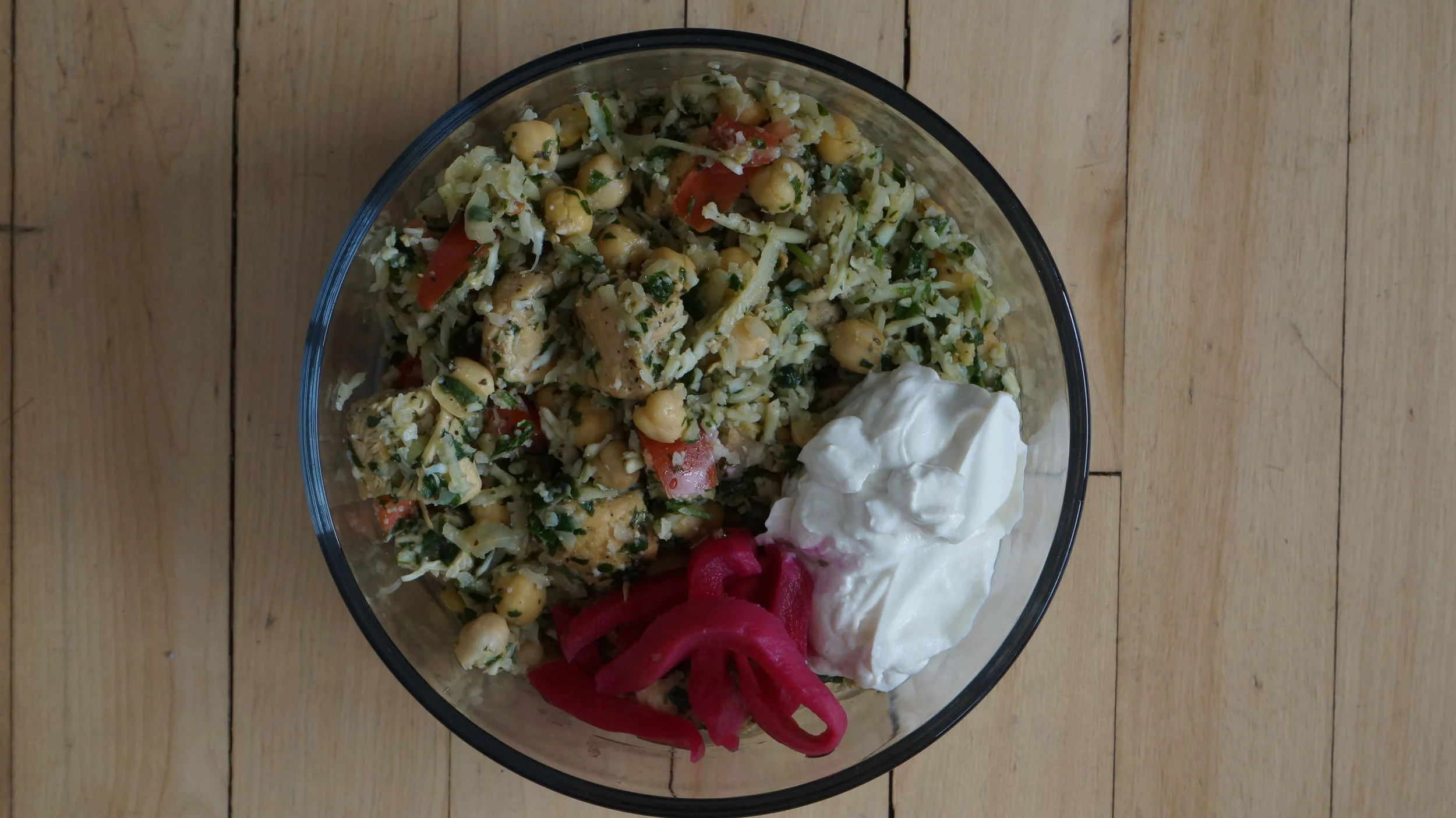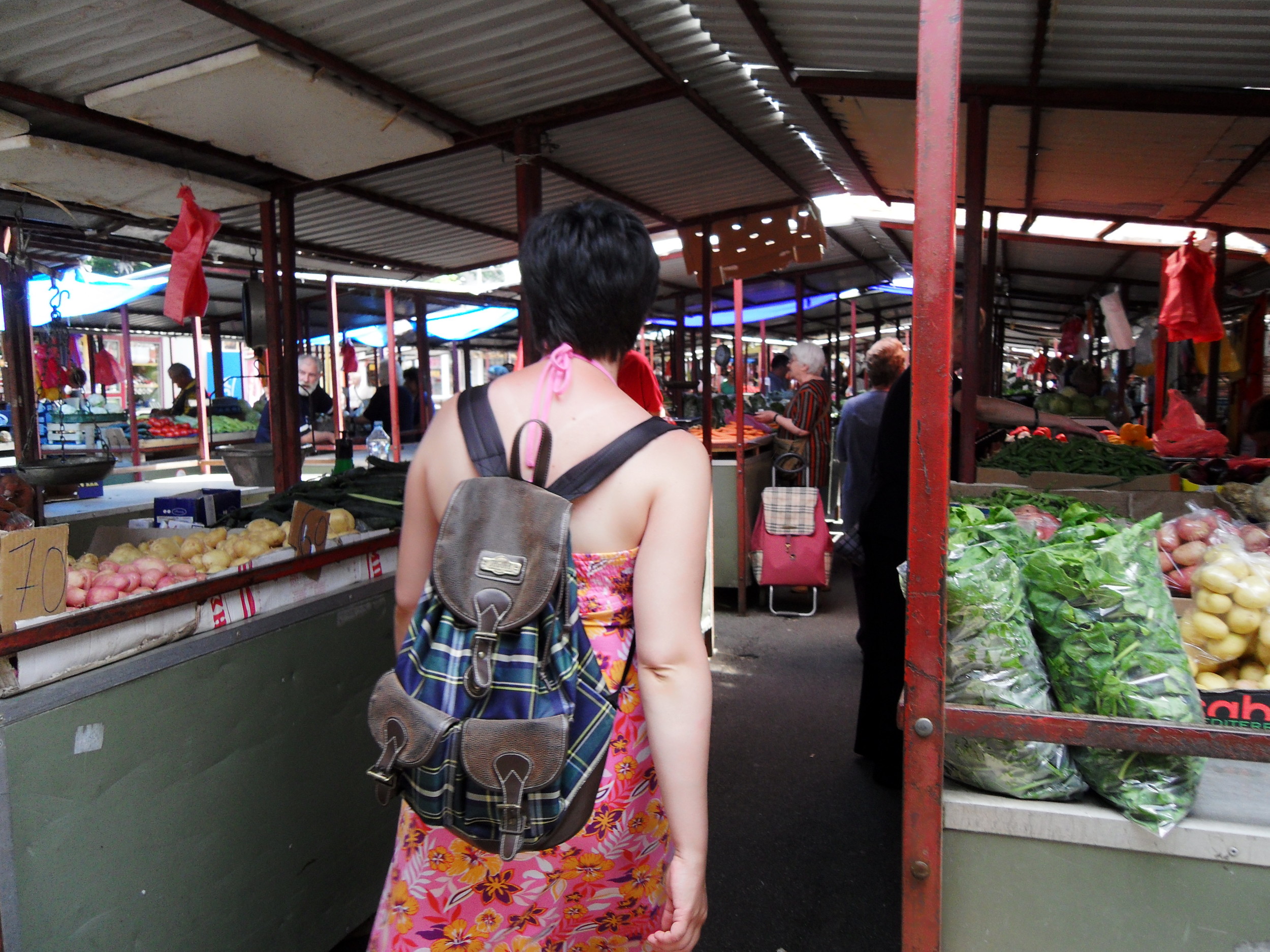I’ve launched my digital cookbook Etsy store! Find out more about my first e-cookbook. This e-book is a one stop shop to a week of meal prepping using fresh seasonal spring ingredients. Additionally you get 1 meal prep guide to making all recipes a efficiently as possible as well as a grocery list to make all 5 recipes.
Cauliflower Rice Tabbouleh
Known as the ‘glitter of food prep’ (as in, it gets everywhere), it may seem like the last thing you want to prep. So why eat it? If you’re gluten intolerant, I find it works really well instead of cous cous when making tabbouleh. It’s pretty neutral in flavour so it can be subbed for grains in popular grain-based salad recipes.
Cooking with Spring Produce
One of my earliest memories as a child was visiting a farmer's market where my family lives in Serbia. I remember being asked what I would like for supper. I insisted on having a cucumber salad at the beginning of May and I couldn't possibly understand that 'it wasn't in season'. Clearly, I was used to the luxury of imported foods. This experience was my first taste of what eating seasonally meant.
Farmer's markets have now become a special outing and a pleasurable shopping experience where you know you'll go home afterward with the most delicious food. They are also a place of conviviality and certainty that your food is fresh and seasonal. As Alice Waters writes in the introduction of Christopher Hirsheimer's Book, San Francisco Ferry Plaza Farmer's Market Cookbook (co-written by Peggy Knickerbocker),
"It starts with a transaction that's essential, an exchange of food, but it widens to include the fundamental experience of being alive. And by providing the element of surprise, going to the market frees us from our rigid agendas and teaches us what being alive can mean."
Hirsheimer is an American author of Canal House Cooking Volumes, a well-known series of amazing, simple and meticulously written recipes. Hirsheimer and Knickerbocker spread their art of cooking authentic cuisine with character and passion.
What I love about the Farmer's Market Cookbook is that they alphabetize produce respective to the season they're available in. Of course, seasonality differs from country to country. Check out your local, seasonal produce guide or chat with a farmer at your local market.
Buying food by the season is a great place to start for anyone interested in eating to improve their health. Starting with a recipe that focuses on one fruit or vegetable that is in season can make any novice cook that much more capable of making delicious food. Fresh, locally produced and organic food inherently tastes better than commercially store bought. Once something is picked, it begins degrading in nutrients and flavour. Farmer's market vendors usually pick their produce the morning it's sold whereas supermarket foods are usually picked before they are ripe and are altered chemically to ripen when they arrive at the store.
Here are some of my favourite spring vegetables in recipe form using some of Hirsheimer's Farmer's Market Cookbook recipes.
~~~~~
Cecilia Chiang's Asparagus with Soy-Sesame Dressing
as adapted by Saveur
I used sea kale in this recipe. It is a Spring vegetable that looks like celery and tastes slightly of asparagus.
1 ½ lbs. asparagus, trimmed and cut crosswise on the diagonal into 2" pieces
1 tbsp. Japanese reduced-sodium soy sauce
1 tsp. Asian sesame oil
2 drops red chile oil
½ tsp. toasted sesame seeds
Bring a medium pot of water to a boil over high heat. Add asparagus or sea kale to pot and cook until tender-crisp and bright green, 1½–2 minutes. Do not overcook. Drain, then immediately plunge into a large bowl of ice water; set aside to cool, 2–3 minutes. Drain again, then transfer to paper towels, pat dry, and set aside.
Whisk together soy sauce, sesame oil, and chile oil in a medium bowl. Add asparagus and toss. Transfer to a serving bowl and garnish with sesame seeds.
~~~~~
Dandelion Salad Lorraine
4 bacon slices, finely chopped
1 shallot, minced
small handful of fresh chives, minced
1 tablespoon red wine vinegar
¼ cup walnut oil
4 large handfulls of small, young dandelion
In a large skillet, cook the bacon over medium-high heat until crisp, about 3 minutes. Using a slotted spoon, remove the bacon to a paper towel to drain.
Put the shallot, chives, vinegar, oil and a pinch each of salt and pepper in a large salad bowl and mix together with a fork. Add the dandelion leaves and bacon and toss until the leaves are evenly coated. Taste and adjust the seasoning with salt and pepper and serve.
~~~~~
Rhubarb with Vanilla and Crème de Cassis
transcribed by Andrea At
2 pounds rhubarb, sliced into 1" pieces
1/3 cup sugar
1/3 cup crème de cassis
1/2 vanilla bean, split lengthwise
Oven preheated to 350F. Stir all of the ingredients together in a large baking dish and bake for about 30 minutes. The rhubarb should be tender and should release some of its juices.
Remove from the oven and take out the vanilla bean. Scrape the seeds into the rhubarb mixture with the tip of a knife. You can serve it warm or cold, over yogurt or whipped cream.
~~~~~
What do you look forward to eat most in the spring?
Coriander Mushrooms & Coffee Granita
Not going to lie, I thought I knew a lot about cooking already before I started the Ballymaloe course.Oh, sure wine goes with food.. yadda yadda. An omelette is a omelette, right?
Ya, no. I learned very quickly that there are incredible intricacies to making these 'every day' dishes that much better. I hate to use the word 'better', though. It reminds me how we use words like 'organic' to imply that the food is 'alternative'. Organic, well made food with care and with good quality ingredients was and should be the norm. Store bought and highly processed should be the 'alternative'.
An Omelette and a Glass of Wine (1984) by the late Elizabeth David is a collection of David's cookery articles she wrote for magazines all over the world. In the title article she talks about making a 'simple omelette' to perfection. She suggests the pan used is very important. Cast iron? Washed or unwashed? If you're wondering.. David uses an aluminum pan, washed up like all other utensils.
David's cookbooks are also part History of English Cookery. In her book Spices, Salt and Aromatics in the English Kitchen (1970), David recounts the gradual progress and integration of spices and herbs in Northerly cooking. The thing that popped into my mind was sustainability. Spices were originally some of the highest priced commodities! Since the poor couldn't afford the luxury of importing such expensive spices and exotic ingredients, they substituted local fare for an attempt at a similar taste and flavour. Some who couldn't afford copious amounts of oil for pickling and canning presumably had to ferment instead. That's where Sandor Katz comes in, right?
Ok, now I'm just picturing a time travel device and am getting really excited.
All in all, Elizabeth's David's cookbooks are "beautifully written, they are full of information allied to inspirational recipes" - Terence Conran's 2006 forward in David's Third Printing of Italian Food (1954).
~~~~~
Omelette Moliere
An Omelette and a Glass of Wine (1984) as transcribed by Leslie Blythe Miller
serves 1
3 eggs
1 Tbs Parmesan, finely grated
1 Tbs butter
1 Tbs gruyère
1 Tbs heavy cream
Beat 1 tablespoon of finely grated Parmesan with 3 eggs. Heat the pan on the stove for about a minute. Put a tablespoon of butter in the pan. When the butter bubbles, and is about to change color, pour in the eggs.
Add one tablespoon of gruyère cut into small dice and one tablespoon of heavy cream. Tilt the pan towards you so that some of the mixture from the far edge runs into the middle. Then tilt the pan away from you. In the time it takes to do this twice, the gruyère will have started to melt, and your omelette is ready. Fold it over in three with a fork, and slide it on to the plate. Serve instantly.
~~~~~
Coriander Mushrooms
Spices, Salt and Aromatics in the English Kitchen (1970) Serves 3
6oz/180g button or closed cap mushrooms
3 tbsp lemon juice, separated
2 tbsp olive oil
1 tsp crushed coriander seeds
2 bay leaves
salt and black pepper
Brush mushrooms with a soft, dry pastry brush and cut into quarters. Toss in a bowl with lemon juice. In a heavy frying pan, warm olive oil. Cook the coriander seeds for a few seconds over a low heat. Add the mushrooms and bay leaves. Season with salt and fresh ground black pepper. After a minute, cover the pan and cook for another 3-5 minutes.
Pour the mushrooms with their cooking juices into a serving dish and sprinkle them with fresh olive oil and lemon juice to taste. Serve chilled, or hot with veal or chicken.
~~~~~
Coffee Granita - Granita al Caffe
Italian Food (1977)
6 oz., 170g coffee
3 oz, 80g castor sugar
2 pt, 1 ¼ L water
¼ pt, 60mL cream (optional)
Put the finely ground coffee and the sugar into an earthenware jug, pour the boiling water over it, and put the jug in a saucepan of hot water. Leave it, with a very gentle flame underneath, and let the coffee infuse for 30min.
Leave it to get cold, strain it through a very fine muslin, and freeze in a non-reactive tray. Stir it every 30min as ice crystals form. It will take 21/2 to 3 hrs to freeze. Fresh cream may be served with it.
The addition to the granita of ¼ pt of cream, after it has been frozen, produces the best and simplest made iced coffee I know.
~~~~~
And - YES I DID! Mmm. How wonderful to be transported back into time when recipes weren't a dime a dozen and to hear a real passion for where food comes from and why. A discussion on Elizabeth David's works is on May 18th at 11:30am. Do you have a favourite cookbook from the 1950s?














